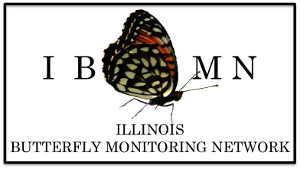Monitoring Guidelines Summary
Basic Guidelines
- The minimum number of site visits per year should be 6. Visits on most sites should take place between June 1 and August 7, with four visits before July 20. (We will let you know if your site should be done at a different time of year). If you want to go out more, and if you want to extend your season earlier or later, that’s great, as long as there are 6 visits in the key time frame of June, July, and August.
- Monitoring is ideally done on sunny days with low wind and temperatures of at least 70 degrees. It can be difficult to get completely ideal conditions, but try to time your monitoring to coincide with at least relatively appropriate weather. Very warm (over 80 degrees) cloudy days can actually be good monitoring days.
- Start your monitoring no earlier than 10:00 AM. Be sure that you are done by 3:30 PM. A typical monitoring route should take 1-2 hours to complete.
- EXTREMELY IMPORTANT: Record your starting and ending time. Observations are translated to individuals observed per hour of observation time. If you don’t tell us when you started and stopped, we can’t make this essential calculation.
- The census route should cover all major habitats and management units within a site. The site steward should be able to assist you with route setting. If this option is unavailable, the Butterfly Monitoring Network can assist.
- Walk the route at a constant pace, stopping only to identify and record butterflies seen within 6 meters (about 20 feet) of the census route. This results in a corridor of 12 meters (about 40 feet). If you stop for a length of time in one spot, do not monitor while stopped, and record the time stopped in the comments section of your field form. Start monitoring once you resume walking.
- The Butterfly Monitoring Network protocol does not include collection of specimens. Unless otherwise directed, you can net butterflies for identification. During the netting process you may place the butterfly in a clear container for better observation. (A clean, plastic jar with small air holes drilled in the lid works well.) Each butterfly should be released as soon as you have identified it. Never place more than one butterfly in the container at a time. Most people find that they need to net fewer and fewer butterflies as they gain experience.
- Identify species only as far as you can with certainty. Many excellent reports include observations such as 2 unidentified butterflies in Transect A, or unidentified skipper in Transect C. Occasionally you will have to report things like Comma/Question Mark if you don’t get a good enough look at something. These less precise observations are still useful data. Never guess. If you don’t know, record it as unidentified.
- Only one person should monitor at a time. It is actually recommended to take someone else along with you, but only one person should spot the butterflies for consistency.
- Please submit data promptly at the end of the season. We send a reminder that it’s time to send your data in or submit it to the website. Now that we have the website to submit data, monitors can keep that up to date each time they monitor if they wish.
Safety
- Consider using the “buddy system” when monitoring, especially if you are on a wetter site where you are wading in water. Any time you are in a natural area, you must consider safety. Accidents do occasionally happen. If you twist an ankle or fall, you will want someone with you who can get help. This second person can function as well as a note taker. You would call out each butterfly as you identified it, and the note taker would then record it for you.
- If you do go out alone, set up a check system with someone. You would call this person before you went into the field, run your route, and then check in with them once you were done. If they didn’t hear from you within a specified length of time, they would come to find you, or notify the authorities, or both. You would need to establish this ahead of time.
- Carrying a cellular phone is also a good idea if you have one.
- Extremely important: If you are allergic to bee stings, carry a bee sting kit. Never make an exception to this rule. Make sure you also go directly to the hospital after using your kit. It is not a cure, but merely gives you time to get help.
- Carry drinking water. It can get quite hot in the field. Take precautions against heat exhaustion.
